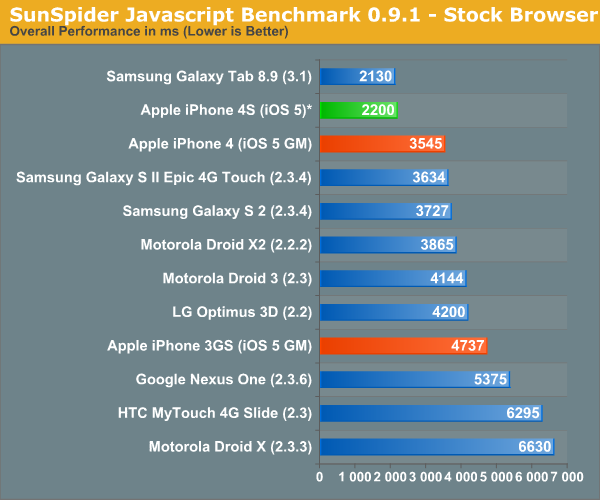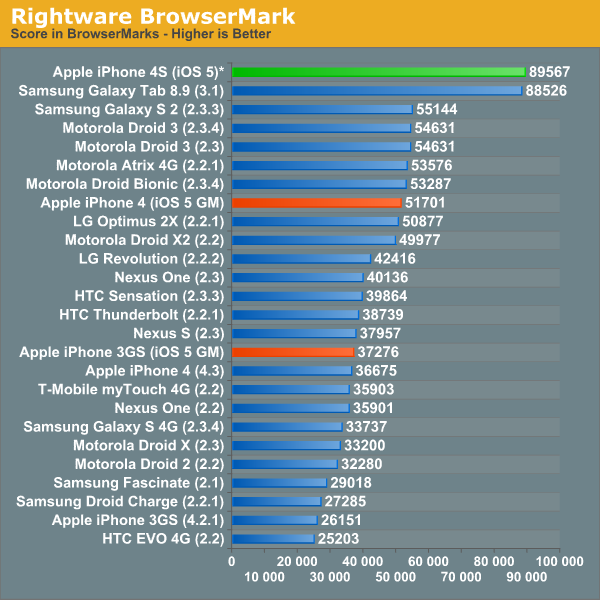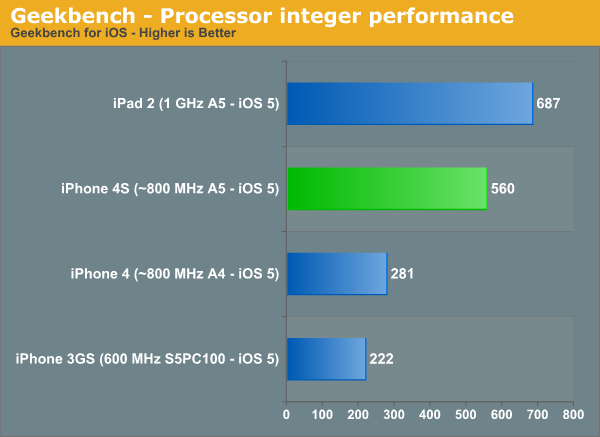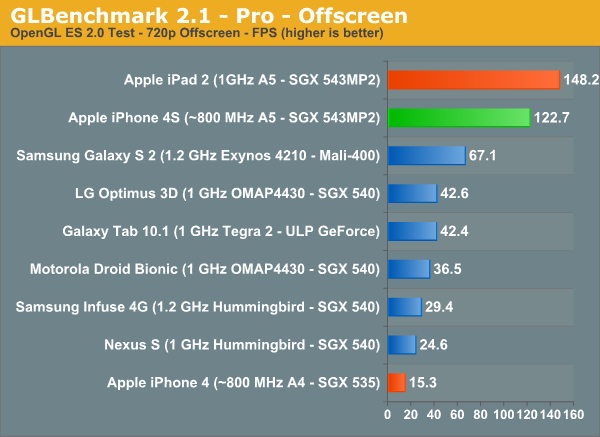iPhone 4S Preliminary Benchmarks: ~800MHz A5, Slightly Slower GPU than iPad 2, Still Very Fast
by Anand Lal Shimpi & Brian Klug on October 11, 2011 3:22 AM EST- Posted in
- Smartphones
- Apple
- Mobile
- iPhone 4S
- SoCs
Apple's ability to control the entire information chain, down to the point of limiting leaks, appears to be gradually slipping as it grows as a company. Case in point are the numerous hardware and performance leaks surrounding the newly launched iPhone 4S. Little did we know that several weeks ago we were staring at photos of the 4S' PCB, and more recently we've seen the first performance results from Apple's first A5 based smartphone thanks to a few eager users around the web. We've compiled these results here from various sources (all linked below) and compared them to our existing database of tests.
The results are pretty much as expected. Javascript performance finally catches up to Tegra 2 based Honeycomb devices, while general CPU performance is significantly higher than the iPhone 4. I suspect Ice Cream Sandwich will bridge the Android smartphone gap (the Honeycomb equipped Gtab 8.9 is here to give you an idea of where a more modern Android browser ends up).
Keep in mind that all of these tests measure performance of the software stack in addition to the hardware. In particular the web browser tests depend largely on browser optimizations, which is why we see differences between similar hardware running different browser versions. Also note that all results were run at stock, with the stock browser. Finally, although these browser tests were captured on video we'll still be running our official tests once our 4Ses arrive and will update accordingly.


Using some of the integer and fp tests of published Geekbench scores we can already conclude that Apple is shipping a lower clocked A5 in the iPhone 4S than it does in the iPad 2. This naturally makes sense as the iPhone 4S has a much smaller 5.25 Whr battery. Based on the Geekbench results it looks like the iPad 2 is clocked around 25% higher than the iPhone 4S, pegging the latter's clock speed at 800MHz.


A lower clock not only means higher yields from the factory, but likely a lower operating voltage as well. Dropping a CPU's core voltage, yields a greater-than-linear decrease in power consumption, making the marginal loss in clock speed a good choice. At a lower operating frequency than its Android competitors, Apple does have to exploit its strengths in software to avoid any tangible performance penalties. Apple has traditionally done this very well in the past, so I don't expect the loss of frequency to be a huge deal to the few who do cross-shop iOS and Android.
Unsurprisingly, memory bandwidth doesn't appear to have gone up either compared to the iPad 2's A5 (taking into account scaling due to CPU clock increases). The Samsung part number on the iPad 2's A5 indicates two LPDDR2-800 die on package, it's safe to assume that whatever Apple clocked the memory interface at in the iPad 2 remains unchanged in the iPhone 4S.
The GPU results tell a similar story courtesy of some early GLBenchmark 2.1 results. The 960 x 640 results are useless as they are bound by vsync at ~60 fps. Luckly GLBenchmark 2.1 added an off-screen render mode at 1280 x 720 where we can really see the differences between the iPad 2 and iPhone 4S A5 implementations:


Here the iPad 2 holds a ~21% performance advantage, which once again I assume to be all related to clock speed. Also note the huge advantage over the existing iPhone 4. The GPU power in the 4S should be more than enough to run any well written, current generation title at well north of 30 fps on its display.
We'll be reviewing the iPhone 4S in the coming weeks, stay tuned!
Source: GLBenchmark Database, Geekbench Database, Macrumors










216 Comments
View All Comments
deV14nt - Wednesday, October 12, 2011 - link
I think you thought the GP was saying something he wasn't....Nevertheless, I'll address your points. I think it could be argued that Apple has focused on the wrong areas. I mean, they improved the performance of the web browser beyond that of the Galaxy S II (which is already very smooth zooming in and out while display Flash animations on a full webpage), but the iPhone still does not display Flash (therefore does not display whole websites), and obviously the screen size is much smaller which also diminishes the web browsing experience.
Similarly, the iPhone now has all this power while you're looking at the home screen, but the home screen doesn't DO anything. No widgets, no live tiles, not even any sort of eye candy. Rows of icons. No form OR functionality to be found there.
So the processor may be helpful for Siri. For games absolutely. But does it improve the overall experience of the phone in the same way that adding any of the above features or increasing the screen size would? Probably not.
Hoggleboggle - Tuesday, October 11, 2011 - link
You might want to re-run the score on the Galaxy S2. I just ran Sunspider 0.9.1 on my stock (international version supplied by THREE) Rom with stock browser and got a score of 3372ms, well below the figure you have listed.Fysi - Tuesday, October 11, 2011 - link
I ran it in Opera Mobile and got 1619.2msLucian Armasu - Tuesday, October 11, 2011 - link
Anand, if you want to show "CPU performance" by using the JS benchmark, it would probably be best if you used a more current 3rd party browser like Opera Mobile or Firefox or Dolphin HD. But if you just want to compare the browsers, then using the stock browser is fair.Brian Klug - Tuesday, October 11, 2011 - link
You're comparing SunSpider 0.9.1 to our 0.9 (for legacy purposes) results. We will be switching to 0.9.1 as soon as we have some more data (else the graph will be very small).-Brian
Fysi - Tuesday, October 11, 2011 - link
I got 1639.6ms +/- 3.8% in Opera Mobile on my SGS2 using 0.9palehorse - Tuesday, October 11, 2011 - link
I wouldn't mind seeing a chart built with all available browsers on both platforms; however, it should probably wait until after ICS gets released.ALL available iOS5 and ICS browsers, as well as the Prime vs. iPhone4S, are the Q4 2011 benchmarks I really want to see...
Commodus - Tuesday, October 11, 2011 - link
As has been pointed out, Android 2.3 won't use a second core in the browser... so many phones have been working with an arm tied behind their back thanks to Google.Android 4 (ICS) hopefully fixes that, but here's where fragmentation takes Android down: you now get to play the guessing game as to when Samsung, or HTC, or Motorola bothers to upgrade your phone, if at all, along with any separate carrier checks. If ICS does use extra cores, the Nexus Prime and their kind will show it, but you still have to buy a new phone.
In the meantime, the iPhone 4S user will still have the practically faster device, and if there's any extra speed to get out of the code, he'll get it without having to wait for an intermediary. Something to be said for having speed in practice versus speed in theory.
Fysi - Tuesday, October 11, 2011 - link
'If ICS does use extra cores, the Nexus Prime and their kind will show it, but you still have to buy a new phone.'But you would have to buy a new phone to get the iPhone 4S....
So I don't exactly see your point there.
Commodus - Tuesday, October 11, 2011 - link
Apologies. The issue is that a lot of Android fans have presumed that the dual-core phones they bought earlier, such as an Atrix 4G or a Galaxy S II, were automatically better -- both because they see higher clock speeds (didn't we settle this debate a decade ago?) and because, quite frankly, they assume that anything using Android has to be better than what Apple makes.Moreover, because of the lack of software optimization on Android, the iPhone 4 from 2010 is in many cases as fast in its browser as a dual-core gigantic Android superphone released just a couple of weeks ago.